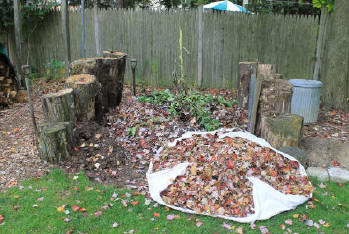 (11/1) AHHH, November, my second favorite month of the year. October is the best – the weather's cooler, leaf colors change, garden chores decrease and then November hits, which is the beginning of the holiday season!
(11/1) AHHH, November, my second favorite month of the year. October is the best – the weather's cooler, leaf colors change, garden chores decrease and then November hits, which is the beginning of the holiday season!
But are there some garden activities that can still be done this month before the holidays start? Why yes, of course!
Did you clean up your veggie garden? If not, that is something that should be completed before planning your Thanksgiving meal. Cleaning up the vegetable garden simply means pulling and composting or bagging all plant debris, whether it’s the vegetable plants, weeds, or rotten vegetables that were left on the plants. This reduces overwintering sites for disease pathogens and destructive insects.
Next, if you haven’t done a soil test in a few years, it would be a good time to do that. The soil test will tell you what nutrients are deficient, if any, what the pH of the soil is and how to adjust it for the vegetables you are growing. Go to your local extension office and purchase a test kit, mail it off, and the results will come back within a week or two. After receiving the recommendations, you can make those adjustments to your soil now, so it will be ready this spring for planting.
The next step for preparing your vegetable garden for winter is to cover the soil. This can be done by covering with compost or a mulch of some kind or seeding in a cover crop. It is getting late in the season to plant a cover crop, but if you do it very soon, you should get germination, and enough cover to get the garden through the winter.
A cover crop can provide a few things. First, it provides stability to the soil to reduce erosion or washing away of any exposed soil. Second, it provides a green compost that can be dug into the soil in the spring and adds organic matter to the garden. Sometimes I have left the cover crop to grow through the spring and interplanted it with the veggies I want to grow. If you choose this option, be sure to choose the best plants that can tolerate a bit of shade, and also choose an annual cover crop like winter wheat that allows for interplanting.
It’s not too late to plant garlic. Garlic bulbs can be purchased at most garden centers. To plant them, break the bulb apart into individual cloves. Plant each clove in its own hole and follow the planting depth recommended on the bag.
The next thing that can be achieved this November is planting bulbs. Often in November there are sales on fall bulbs. Check the bulbs for firmness before planting. Follow the suggested depth of planting so they don’t rise out of the ground with freezing and thawing. This late in the season doesn’t allow much time for the bulbs to push roots that hold them in for the winter season. Therefore, following the soil depth recommendations are important.
Empty pots. If soil is left in clay or ceramic containers, they will crack and potentially break apart. Cleaning them of residue and storing them in a garage, shed or basement are best practices for containers used from year to year.
Bring any tropical plants indoors that can be saved through the winter. Use an insecticidal soap or houseplant horticulture oil spray to get rid of any insects that may be feeding on the plants. Put the plants in the sunniest window you have. Chances are leaves will drop and the plant could go into dormancy, but if you can keep it watered, and provide light, it should survive till it’s time to put it back outside in the spring.
Lastly, plant seeds. What? Yes, seeds that require stratification (a cold treatment in order to break dormancy) can be directly sown into the planting bed. This will provide that required cold treatment naturally. Many of the native perennial and grass species require this cold time to germinate.
And after digging, planting, and mulching, clean the tools that are used and store them for the winter. Wash off all the soil with a hose, use steel wool to rub away any rust that may have started, and use a soft cloth and rub oil on the steel. This will keep your tools in the best shape while not using them.
While finishing the last of the garden chores, remember there are some things that are better left until spring. First, don’t bother with cutting down perennials. The seeds left on the flower stalks will provide food for the birds, and the broken stems will provide a place for overwintering native bees to live until spring. However, effort put into pulling any weeds before winter sets in will reduce the number of weeds to manage in the spring. Secondly, pruning this time of year is not recommended. Wait until late winter to get out those pruning loppers and saw. Cutting back a woody plant could allow for pathogens during the winter months.
Enjoy the upcoming season of garden rest!
Read other fall related gardening articles